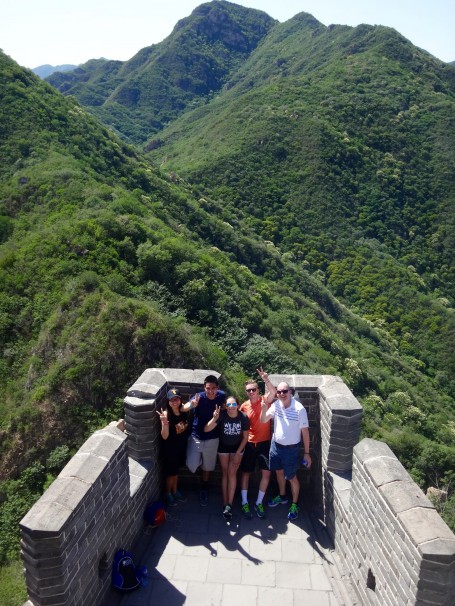By: Jon Peppin, Psalm Chang, & Michelle Ngan
It’s hard to believe that we have only been in China for three days! In that time, we have been able to learn so much about the culture here in Beijing.
We were warned by Professor Sheehan that today was going to be a busy day, and he definitely wasn’t lying. One of the most amazing things we did was climb the Great Wall — specifically, the Juyongguan section. It was truly an awe-inspiring and tiring experience! Most of us were able to climb past four guardposts. Ashley, Psalm, Jon, Chris, and Professor Sheehan took it to a whole new level and made it up to the farthest part of the portion by climbing past seven guardposts, thereby earning official Sheehan points! The view at the top was simply breathtaking. Just imagining the amount of effort that went into building the wall, with its uneven steps and two distinct sides to the wall (i.e. one side being taller to keep the Mongols out) made us realize what a privilege it was to be there. When we made it back down to the bottom of the mountain, we rewarded ourselves with some iced tea and ice cream. Thanks Papa Sheehan!

Depiction of the victorious 4 students who gained official Sheehans for making it to the highest point of the Great Wall (Juyuguan section) and of course, proud Papa Sheehan.
Before climbing the Great Wall, we went to see the Ming tombs, particularly the Changling tomb, the tomb of the third emperor, Zhu Di and his wife, Empress Xu. An interesting fact that our tour guide told us was that even though there were 16 Ming emperors, there were only 13 tombs because the other emperors were buried outside of Beijing, in Nanjing. There were several parts of the enormous tomb: Ling’enmen gate (Gate of Emminent Favor), Ling’en Hall (Hall of Emminent Favor), Minglou (soul tower), and Baoding (where the Emperor and Empress are buried).
The Sacred Way was a nice breath of fresh air after being in the sun. We strolled through the path, which the emperor would walk through on the way to the Ming Tombs, except we went the opposite direction, since we had just come from the Ming Tombs. This stop was an example of dis-embedding because we were viewing the Sacred Way as a tourist attraction by stopping to take pictures and admiring the scenery. This was contrary to what would have happened at the time it was built or what the emperor used the path for.
To get a more modern perspective on Chinese architecture, our tour group then journeyed to the heart of Beijing to view the national symbols of the 2008 Beijing Olympics. It was truly awe-inspiring to look upon the Bird’s Nest and the Water Cube up close; it’s crazy to imagine that it has been 6 years since Beijing hosted the Olympics––we were just 6th, 7th, and 8th graders at the time! Oh, and we can’t forget Chris’s 15 seconds of fame when a mob of ladies decided to get pictures with him in front of the Olympic buildings. Mr. Carpenter then proceeded to talk about nothing except his claim to fame, and his plans to take Kaifeng by storm.
Just a bit about our research project progress- we, the “grab bag” group, were finally able to narrow down our topic by focusing on the pervasiveness of religion through various forms of expression (e.g. restaurants, fashion, and electronics). We’ll be conducting more field work tomorrow!

